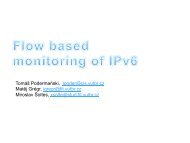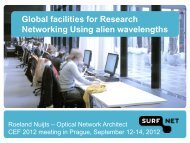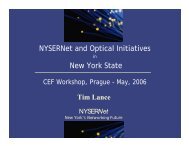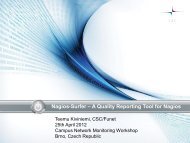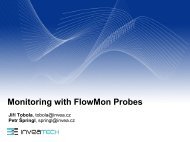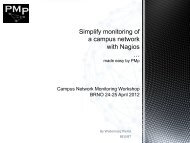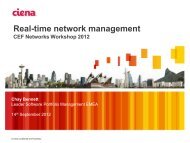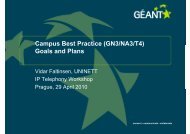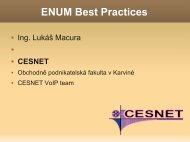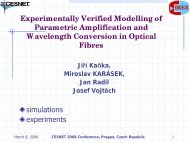2002 - cesnet
2002 - cesnet
2002 - cesnet
You also want an ePaper? Increase the reach of your titles
YUMPU automatically turns print PDFs into web optimized ePapers that Google loves.
Most of the problems connected with the migration of the existing operationwere resolved in the end (e.g., implementation of operations such as Fix or Description,which appear in RT as a new transaction type). We keep on work onadapting of the Web interface needed and creating operating reports.For operating reasons, we changed the server name to rt.<strong>cesnet</strong>.cz and establishednew certificates as well. We preserved the backward compatibility oflinks and old URLs, which occur in the archive-type mails, remain functional.In addition, we managed to migrate to a newer authentication subsystem (wealso fixed the problem with setting of the REMOTE_ USER variable) and testedacquisition of the basic user authorization data (including the proper nationalencoding representation) from LDAP.By modifying the enhanced_mailgate, we prepared the system for collaborationwith the planned authenticated e-mail correspondence. One of our outputs wasthe elaboration of a new RT2 user documentation. The benefits of the existenceof this publicly available documentation was proven in a short time, since wewere contacted by several other persons interested in the local modificationswe performed. A similar situation occurred in the world after the Forward functionin the new RT2 was published in the mailing list of RT users and developers.Consequently, before elaborating an extensive and detailed technical report,we dealt with minor tasks, which represent the cornerstones of the final form ofthe support system. These tasks included, mainly, the final implementation ofthe automated user creation upon their first authentication with CAAS, whichsets appropriate RT records according to the basic user data obtained fromLDAP and defines, as a minimum, the basic access rights for the new user. Userstherefore immediately get the possibility to search and view all requests inRT and comment them (or reply to the requesting person), without having toask the administrator of corresponding queues for allocation of the basic rights.This, naturally, does not mean that users automatically become queue manipulators.Thus, a way for possible further automation of the authorization information exchangeis created. The management of the authorization information dependson administrators of individual request queues for now (this solution has beensufficient so far). We have published the developed source code, as well as thecode that allows display of keywords in the request search results in the outputWeb page (here, the topic area is configured specifically).Another very important step was the successful implementation of all our localmodifications to the latest stable RT version (2.0.15, to be specific). In this way,we also removed several minor bugs (for example double display of merged requests)and mainly obtained better possibilities for applying potential patchesto bugs found by other developers in this long-accepted stable version. WhenHigh-speed National Research Network and its New Applications <strong>2002</strong>189



